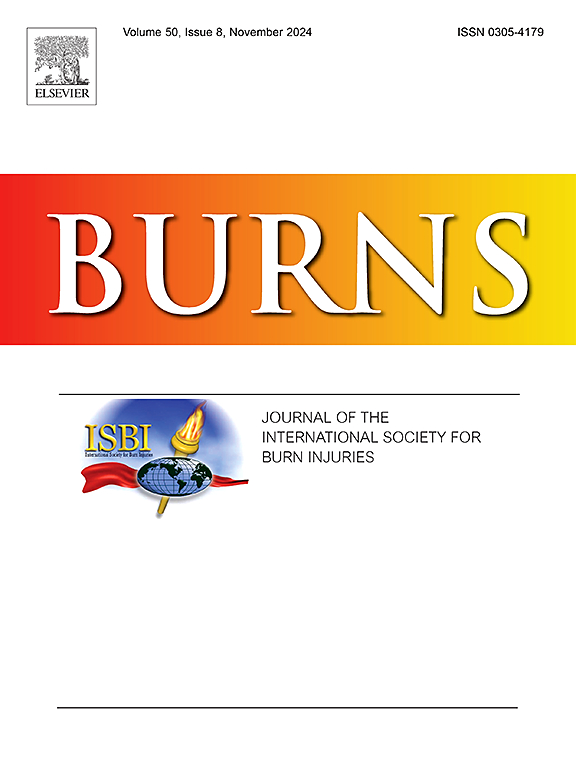大面积烧伤(TBSA ≥50%)患者最常采用的伤口覆盖技术的效果比较 - 系统综述与荟萃分析
IF 3.2
3区 医学
Q2 CRITICAL CARE MEDICINE
引用次数: 0
摘要
本文章由计算机程序翻译,如有差异,请以英文原文为准。
Outcome comparison of the most commonly employed wound coverage techniques in patients with massive burns ≥50% TBSA – A systematic review and meta-analysis
Introduction
Early wound coverage is one of the most essential factors influencing the survival of extensively burned patients, especially those with a total body surface area (TBSA) burned greater than 50 %. In patients with limited donor sites available for autografting, techniques such as the Meek micrograft procedure or cultured epidermal allografts (CEA) have proven to be viable alternatives. In this systematic review and meta-analysis, we analyzed the outcomes of different wound coverage techniques in patients with massive burn injuries ≥ 50 % TBSA in the past 17 years.
Methods
The EMBASE, PUBMED, Google Scholar and MEDLINE databases were searched from inception to December 2022 for studies investigating major burn reconstruction (>50 % TBSA) with the use of one of: a) autografts, b) allografts, c) cell-based therapies, and d) Meek micrografting. The review was conducted in accordance with the PRISMA guidelines. The outcomes evaluated were mortality, length of hospital stay, graft take and number of operations performed.
Results
Following a two-stage review process, 30 studies with 1369 patients were identified for analysis. Methods of coverage comprised the original autografting, and the newer Meek micrografting, CEA autografting, and allografting. Pooled mean age of the entire cohort was 32.5 years ( ± SE 3.6) with mean burn size of 66.1 % ( ± 2.5). After pooling the data, advantages in terms of mortality rate, length of stay, graft take and number of required surgeries were seen for the Meek and CEA groups. Mortality was highest in patients treated with autografts (50 %) and lowest with cell-based therapy (11 %). Length of stay was longest with cell-based therapy (91 ± 16 days) and shortest with Meek micrografting (50 ± 24 days). Graft take was highest with autografts (96 ± 2 %) and lowest with cell-based therapy (72 ± 9 %). Average number of operations was highest with cell-based therapy (9 ± 4) and lowest with Meek micrografting (4 ± 2).
Conclusions
Comparison of the four techniques highlighted differences in terms of all outcomes assessed, and each technique was associated with different advantages. Interestingly autografting, the option with the highest graft take rate, was also associated with the highest mortality. This study not only serves to provide the first comparison of the most commonly used techniques in major burn reconstruction, but also highlights the need for prospective studies that directly compare the efficacy of the different techniques to ultimately establish whether a true superior option exists.
求助全文
通过发布文献求助,成功后即可免费获取论文全文。
去求助
来源期刊

Burns
医学-皮肤病学
CiteScore
4.50
自引率
18.50%
发文量
304
审稿时长
72 days
期刊介绍:
Burns aims to foster the exchange of information among all engaged in preventing and treating the effects of burns. The journal focuses on clinical, scientific and social aspects of these injuries and covers the prevention of the injury, the epidemiology of such injuries and all aspects of treatment including development of new techniques and technologies and verification of existing ones. Regular features include clinical and scientific papers, state of the art reviews and descriptions of burn-care in practice.
Topics covered by Burns include: the effects of smoke on man and animals, their tissues and cells; the responses to and treatment of patients and animals with chemical injuries to the skin; the biological and clinical effects of cold injuries; surgical techniques which are, or may be relevant to the treatment of burned patients during the acute or reconstructive phase following injury; well controlled laboratory studies of the effectiveness of anti-microbial agents on infection and new materials on scarring and healing; inflammatory responses to injury, effectiveness of related agents and other compounds used to modify the physiological and cellular responses to the injury; experimental studies of burns and the outcome of burn wound healing; regenerative medicine concerning the skin.
 求助内容:
求助内容: 应助结果提醒方式:
应助结果提醒方式:


